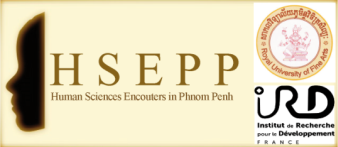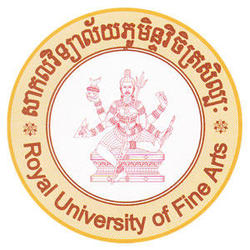Project initiators and partners
Initiators
UMI 233 trans VIH MI/INSERM U 1175
Université Royale des Beaux Arts Phnom Penh
Partners
http://sites.sas.upenn.edu/tlc/
logo tlcAgence Universitaire de la Francophonie - Bureau Asie Pacifique
HSEPP support the Manusastra Project
Lost and Found: A Pre-Angkorian Buddha in Disguise at Longvek
"Lost and Found: A Pre-Angkorian Buddha in Disguise at Longvek" By Nicolas Revire
Abstract:
A few decades after the fall of Angkor, Longvek was chosen by King Ang Chan I (r. 1516-1566) as the new capital of the Khmer kingdom. Located halfway between Phnom Penh and the southern end of the Tonle Sap, Longvek lies just north of Oudong, in the province of Kampong Chhnang where several Pre-Angkorian monuments, fragments of inscriptions, and sculptures have been found. Longvek fell, in turn, to the Siamese in 1594.
The famous temple of Wat Tralaeng Kaeng was built at Longvek’s center during this period of King Ang Chan’s presence. However, several mounds around the site indicate possible earlier foundation remains. Indeed, a rare Pre-Angkorian image of the Buddha seated in bhadrāsana, that is, the sitting posture with two legs extended and the feet firmly planted on the ground, was discovered by French archaeologist Robert Dalet at Wat Tralaeng Kaeng in the early twentieth century. It was also observed in situ by Madeleine Giteau in 1970 but already in a dilapidated state. After the Cambodian-Vietnamese War (1977-1991), western observers reported the statue lost or stolen.
However, on a recent field trip to Longvek, I rediscovered the Buddha image residing in a separate shrine located on the platform of Wat Tralaeng Kaeng. The statue is now in the guise of a powerful Neak Ta, i.e., a so-called land spirit or guardian deity of folk Khmer religion. The local population has given the statue in this incarnation the title Lok Ta Thommareacha (Dhammarāja), namely “the ancestor, King of Dharma”. This case is a rare, perhaps unique, illustration of how a Pre-Angkorian Buddhist statue has been appropriated, transformed, possibly displaced, and later enshrined as a Neak Ta in a post-Angkorian site.
Biodata :
Nicolas Revire graduated from the University of Paris 3-Sorbonne nouvelle in France. He is a full-time lecturer at Thammasat University in Bangkok since 2003, and currently a guest lecturer at the Royal University of Fine arts, Phnom Penh (Manusastra Project). He specialises in the early art and archaeology of Southeast Asia with a research focus on Buddhist iconography.








